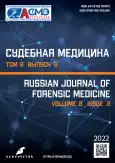Detection of fragments of an obstacle and a projectile in a gunshot injury
- Authors: Leonov S.V.1,2, Pinchuk P.V.1,3, Suhareva M.A.2, Shakiryanova J.P.1,2
-
Affiliations:
- Chief State Center for Forensic Medicine and Forensic Expertise 111
- Moscow State University of Medicine and Dentistry named after A.I. Evdokimov
- The Russian National Research Medical University named after N.I. Pirogov
- Issue: Vol 8, No 2 (2022)
- Pages: 73-80
- Section: Case reports
- URL: https://ogarev-online.ru/2411-8729/article/view/122483
- DOI: https://doi.org/10.17816/fm423
- ID: 122483
Cite item
Full Text
Abstract
BACKGROUND: Law enforcement agencies look for the presence of an obstacle between the human body and the muzzle of a firearm at the time of the shot when assigning forensic medical examination of a firearm injury. Imported particles removed from the corpse, a skin flap, or damaged clothing could be sent for a laboratory examination.
CASE PRESENTATION: Here, we present a case from expert practice which demonstrates the possibility of establishing the presence of barrier particles on surrounding objects in the case of a gunshot injury caused to a person. In the given case, detecting the fragments of an obstacle (triplex ― the windshield of a car) played a leading role in proving the suspect’s involvement in the incident under investigation. Described are the violations of an expert method of particle removal (in one case only, the material obtained from the clothing was placed on a special carbonic adhesive tape during a targeted search of micro overlays) and evaluation of the obtained data which contributed to incorrect findings in the expert’s conclusion.
Experts of the Federal State-Owned Institution “111 Main State Center for Medical and Forensic Examinations” conducted a re-examination of the above-stated objects, as well as experimental target shooting with similar weapons through a similar barrier. Presented are the possibilities of modern scanning electron microscopy and energy dispersion analysis, which allow not only to establish the presence of barrier particles on surrounding objects but also to identify the signs of gunshot damage inflicted upon a human body and clothing, identify the destroyed projectile particles, and establish the elemental composition of all the detected microparticles.
CONCLUSION: This study demonstrated the methodological gaps in establishing the existence of a passage of a firearm projectile through an obstacle in the case of a gunshot injury. The methods for identifying the fragments of a firearm projectile and particles of an obstacle, which we are currently developing, are aimed at solving this problem by improving the corresponding research methods in forensic medicine and science.
Full Text
##article.viewOnOriginalSite##About the authors
Sergey V. Leonov
Chief State Center for Forensic Medicine and Forensic Expertise 111; Moscow State University of Medicine and Dentistry named after A.I. Evdokimov
Email: sleonoff@inbox.ru
ORCID iD: 0000-0003-4228-8973
SPIN-code: 2326-2920
MD, Dr. Sci. (Med.), Professor
Russian Federation, Moscow; MoscowPavel V. Pinchuk
Chief State Center for Forensic Medicine and Forensic Expertise 111; The Russian National Research Medical University named after N.I. Pirogov
Email: pinchuk1967@mail.ru
ORCID iD: 0000-0002-0223-2433
SPIN-code: 7357-3038
MD, Dr. Sci. (Med.), Associate Professor
Russian Federation, Moscow; MoscowMarina A. Suhareva
Moscow State University of Medicine and Dentistry named after A.I. Evdokimov
Email: suha@yandex.ru
ORCID iD: 0000-0003-3422-6043
SPIN-code: 4692-0197
MD, Cand. Sci. (Med.)
Russian Federation, MoscowJuliya P. Shakiryanova
Chief State Center for Forensic Medicine and Forensic Expertise 111; Moscow State University of Medicine and Dentistry named after A.I. Evdokimov
Author for correspondence.
Email: tristeza_ul@mail.ru
ORCID iD: 0000-0002-1099-5561
SPIN-code: 1429-6230
MD, Dr. Sci. (Med.)
Russian Federation, Moscow; MoscowReferences
- Fedorenko VA, Pereverzev MM. Features of establishing the place of the shotwhen the projectile penetrates some transparent materials. Expert-criminalist. 2007;(3):10–14.
- Leonov SV, Pinchuk PV, Sukhareva MA, Shakiryanova YuP. Characteristics of shell fragments after hitting triplex car glass with shots from a hunting "Saiga" carbine under the 5.45×39 cartridge. Russian Journal of Forensic Medicine. 2021;7(3):139–145. (In Russ). doi: 10.17816/fm381
- Leonov SV, Pinchuk PV, Suhareva MA, Shakiryanova JP. Features of the trajectory of particles of car triplex glass damaged by "Saiga" carbine shots with the cartridge 5.45×39 mm. Forensic Medical Expertise. 2021;64(6):18–20. (In Russ). doi: 10.17116/sudmed20216406118
Supplementary files










